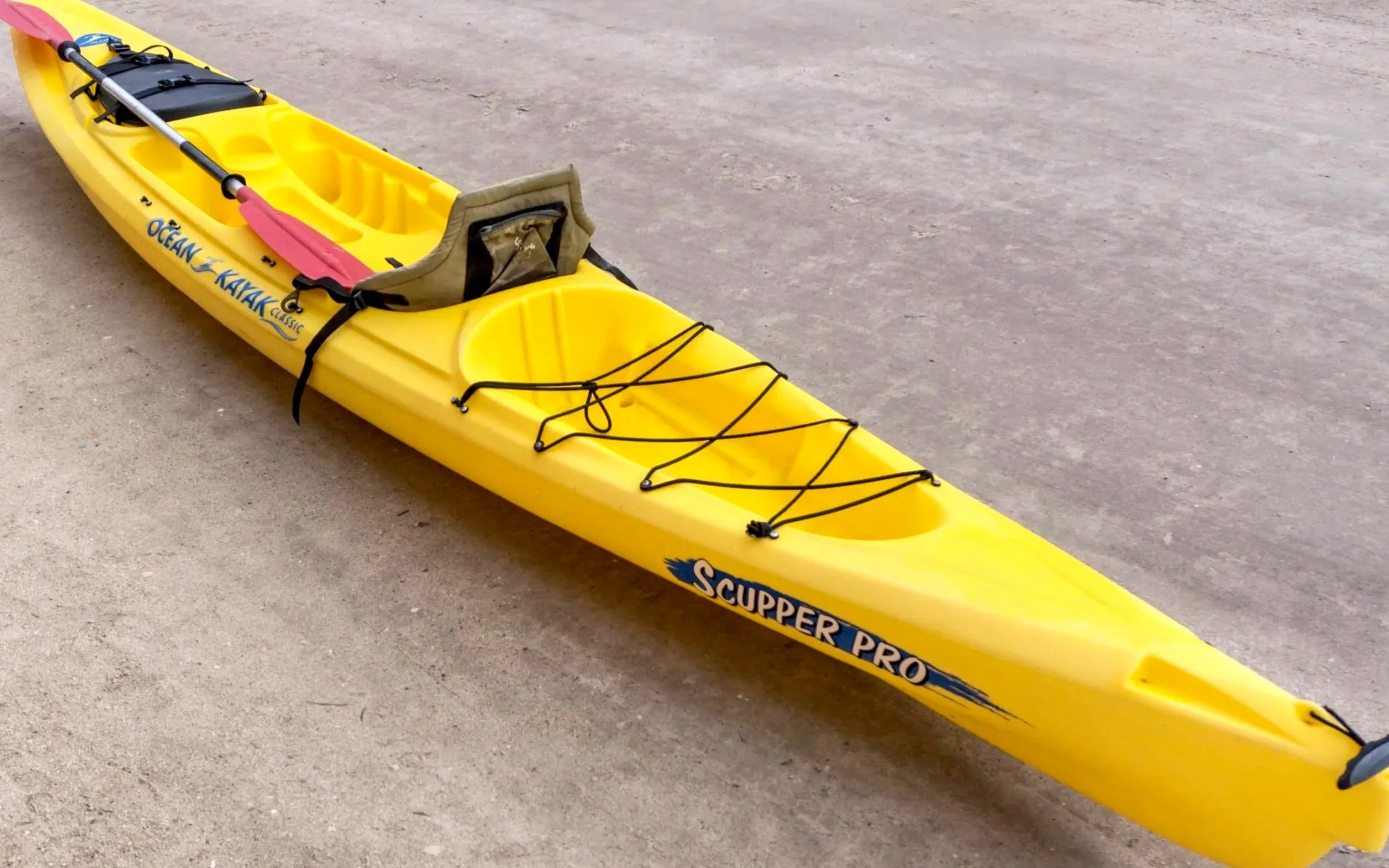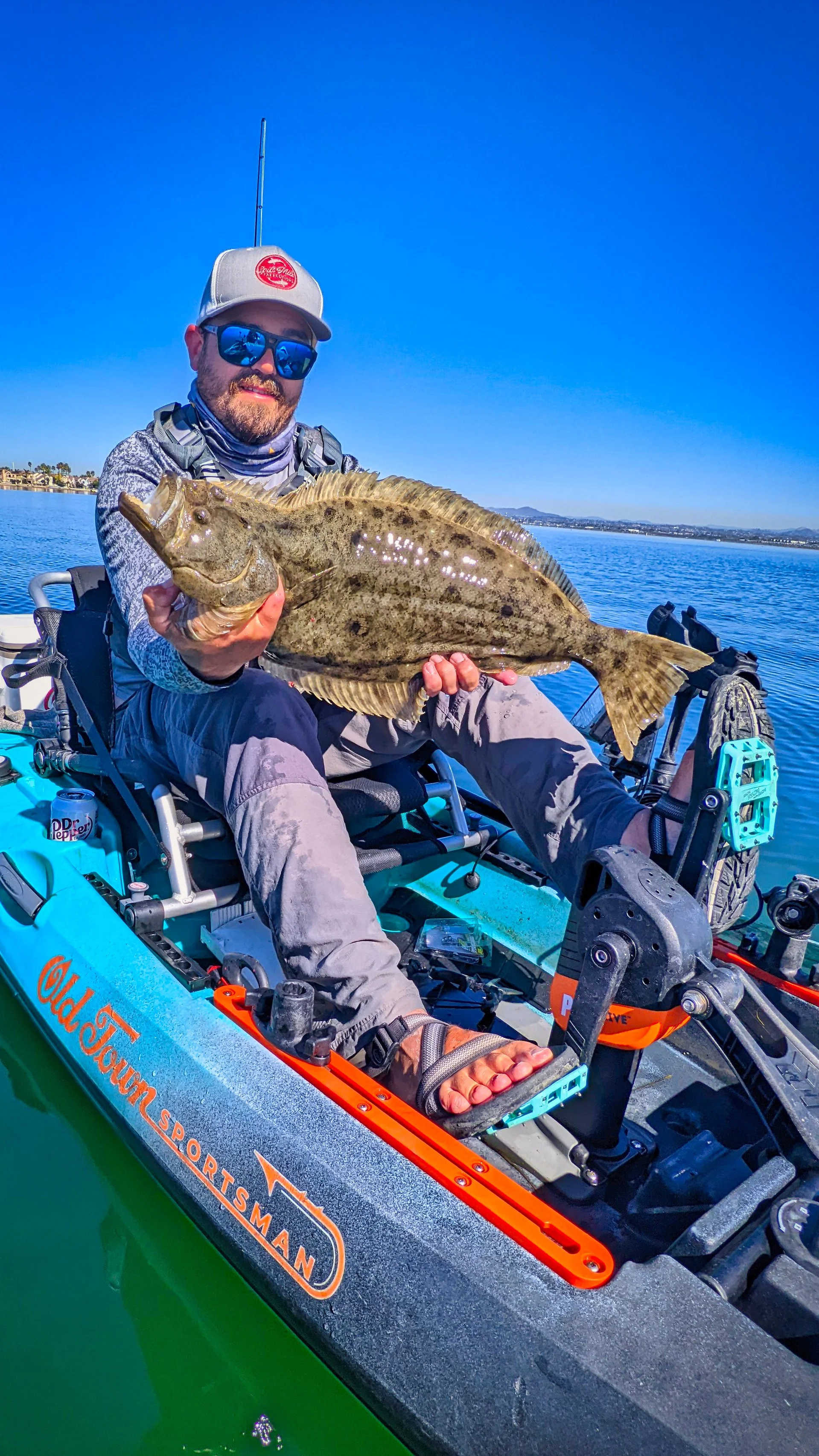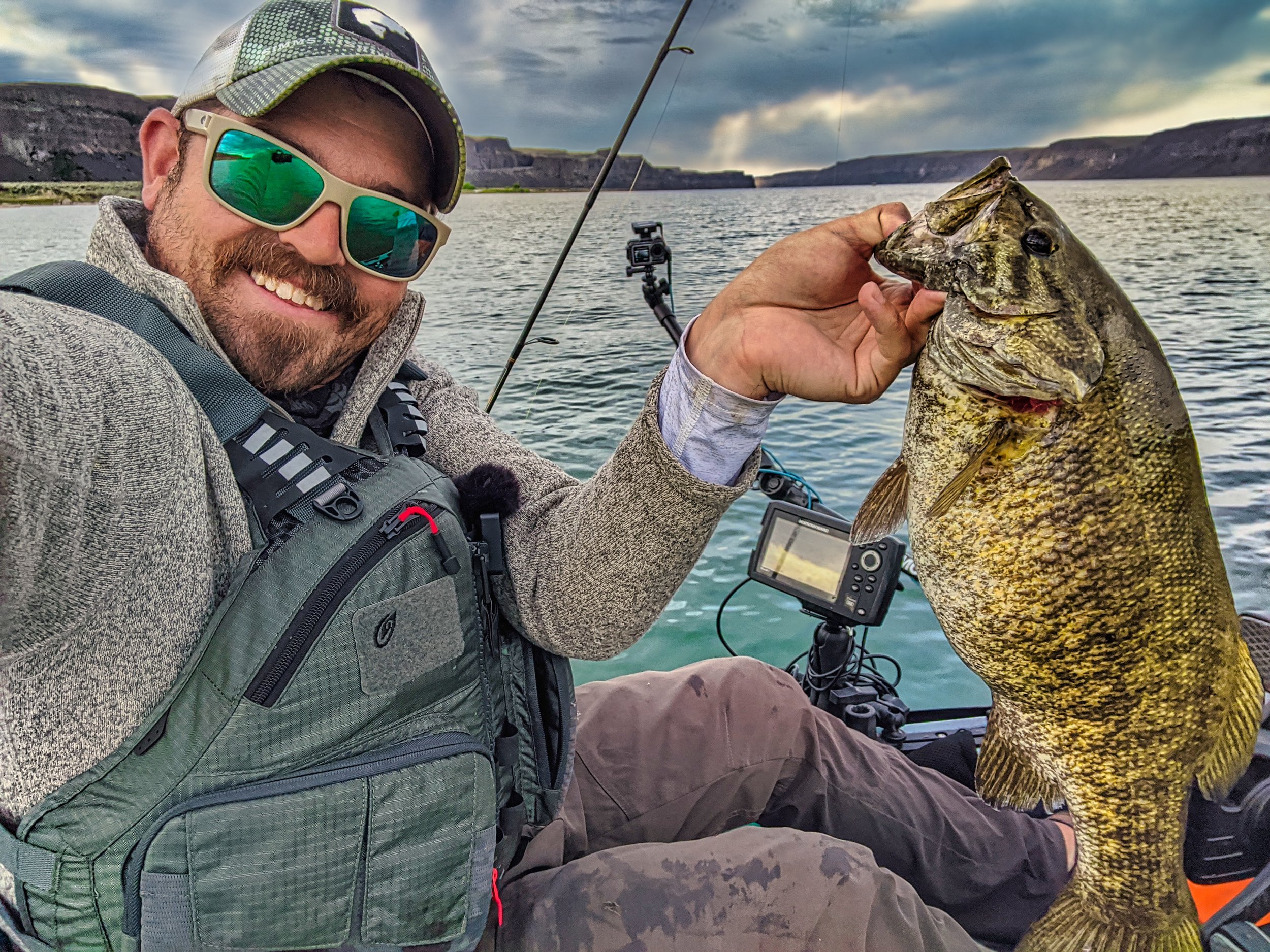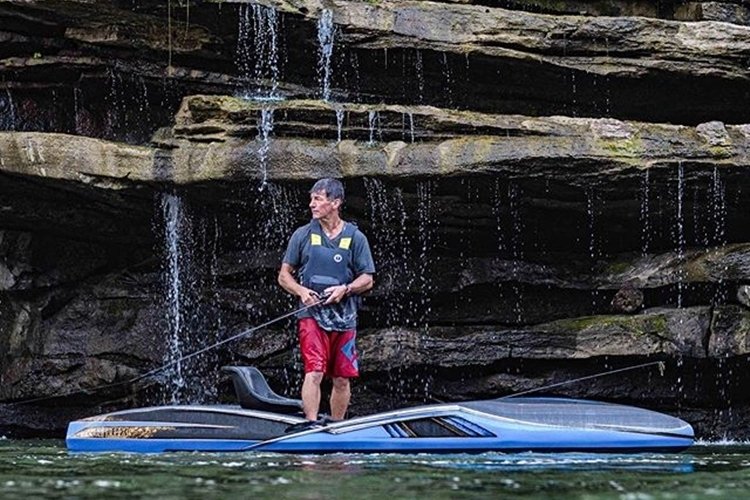Is kayak bass fishing ruining kayak fishing?
It might be hard to believe but fishing kayaks were once light, fast, long, skinny, and affordable and not the fat, slow, short, and expensive barges that dominate the market today. Born from fiberglass self draining sit-on-top designs developed by Tim Niemier, the original “Scupper” kayak has its roots in California’s longboard culture but anglers and spear fisherman quickly realized the potential of the design. In 1972 Tim launched Malibu Ocean Kayak which later became Ocean Kayak. In the mid 1980’s Ocean Kayak revolutionized the industry when they began rotomolding the Scupper Classic and Scupper Pro kayak. Less expensive and more durable than fiberglass, sales sky rocketed and several competing companies began making rotomolded kayaks as well. Since then fishing kayaks have diversified into a variety of shapes and sizes. Notable leaps within the industry occurred when Hobie introduced the Mirage pedal drive in 1997 and Ocean Kayak released the Torque, a motorized version of their Trident kayak, in 2009 (perhaps a little too ahead of its time). As an active participant in the sport and industry over the past decade the changes I’ve seen in the industry are profound some for the better and some not.
The Rise of Fat heavy slow kayaks
The Ocean Kayak Classic Scupper Pro is the forefather of modern fishing kayaks.
The original Scupper Pro kayak (photo left) measured 14’8” and weighed only 55 lbs. Unlike modern fishing kayaks it lacked many of the amenities we have come to expect on modern fishing kayaks such as rod holders, transducer mounts, raised seats, and track systems. At just 26” wide, considerably skinnier than modern fishing kayaks, the Scupper Pro achieved stability by lowering the center of gravity with its recessed cockpit that brought the angler closer to the water. Well adapted to the West Coast’s demanding surf launches and big water the Scupper kayak series was hugely popular and it’s still regarded as one of the fasted sit-on-top rotomolded fishing kayaks ever built, with experienced paddlers capable of hitting 6+ mph.
Contrast that with the four most popular fishing kayaks today the Hobie Pro Angler 12 and Outback, Old Town’s Sportsmans PDL 120, and Native Slayer Propel 12.5 Max and the differences are striking. These kayaks range from 85-105 lbs without their pedal drives and seats, carry significantly more girth at 34-36” wide, and none are over 13’ in length. Most of these highly stable fishing kayaks will be lucky to break 4.5 mph.
What happened?
Me with a giant fish taco caught on my Old Town Salty 120 PDL
In 1997 Hobie released their first pedal drive kayak on the market. A full decade later Native kayaks came out with the first prop pedal drive system. Since then nearly every major kayak manufacturer has released their own pedal drive version or have adopted Hobie’s original mirage drive design after the patent expired. The innovation of pedal drives and motorized kayaks and their meteoric rise in popularity marked the beginning of the fat, slow, and heavy kayak era.
Prior to pedal drives, kayaks were by necessity designed to be easy to paddle. A fat heavy slow kayak that was tiring to paddle would never compete in the open market. The efficiency of pedal drives and the larger muscle groups used in that method of propulsion freed engineers to develop kayaks without the constraints of paddling hydrodynamics in mind.
The first decade or so after the turn of the 21st century saw a massive explosion in the diversity of hull and propulsion designs as kayak manufacturers competed for various niche markets. For kayak anglers it was a glorious time to be alive. There was seemingly a kayak for every fishery. The glory days didn’t last long though.
With its abundance of kayak friendly water and weather, the southeastern United States became the dominant kayak fishing market. The most popular fishery in this region and across most of the eastern United States is bass. Kayak manufacturers rushed to meet demands for ever more stable kayaks with higher weight capacities, more comfortable seating, and more space to accommodate gear intensive bass fisheries. These heavy and extremely stable kayaks also served the region’s inshore kayak fisheries well, where sight fishing for redfish, sea trout, and snook reign. Additionally, these ultra stable fishing platforms were now more appealing than ever to anglers who were initially deterred by the “tippy” feeling of earlier paddle based fishing kayak designs.
By 2015 cracks began to show in the industry when Native Kayak discontinued their Manta Ray 12’ and 14’ series of offshore paddle kayaks. A few years later kayak bass fishing tournaments began to hit their stride and explode in diversity and size. Kayak manufacturers saw an opportunity to capitalize on sponsorships and increase their exposure to kayak anglers willing to spend money on ever more expensive and feature rich kayaks. Around the same time Hobie launched its Bass Open Series, a nationwide kayak bass fishing tournament series and the Kayak Bass Fishing league launched numerous small tournament trails across the country.
Pedal drives have freed kayak designers to make wider and more stable fishing kayaks appealing to wider range of anglers.
In 2020 the pandemic fueled an explosion in demand for fishing kayaks as people found themselves with considerable extra time. Sitting alone on a kayak, stabbing fish in the face, was one of the few safe things to do. Demand for kayaks far outstripped production capabilities. With limited space and ovens to bake kayaks, manufacturers switched into triage mode focusing production on the more popular fat heavy and slow kayak models that were selling at record pace.
In 2020 Wilderness Systems discontinued the Tarpon 160 offshore kayak and likewise Hobie dispensed with the Hobie Revolution 16 much to the chagrin of many offshore anglers. In 2021 Hobie signed on powerboat bass pro Mike Iaconelli and released a specially branded version of its Pro Angler 360 series kayak. Despite its near $6000 price tag it continues to sell well. Finally in 2022 Johnson Outdoors, the parent company of Ocean Kayak, discontinued its entire line of fishing kayaks including the Prowler and much loved Trident series of kayaks. With the demise of Ocean Kayak’s fishing line-up the storied history of the sit-on-top kayak had finally come full circle. The very company that had given birth to the kayak fishing industry now has little more than a single tandem paddle fishing kayak in its lineup.
Capitalism Sucks
I can hear you screaming “Commie!!!” from the other side of the screen but it’s true. There are remarkably few large domestic fishing kayak manufacturers. Several of these are based in the southeastern United States and those that aren’t are deeply entwined with major kayak bass fishing tournament series which are predominately southeastern US based. The importance of bass and bass fishing to these companies is undeniable. You can see it in the predominance of bass content in their social media feeds and in the amount of money being spent to pump up and sponsor bass tournaments and tournament kayak anglers across the region. I can only assume the amount of time and money being spent is a reflection of kayak bass related sales or sales potential.
Is kayak bass fishing ruining kayak fishing?
Yes I love kayak bass fishing but I fear the impacts of the kayak fishing industry’s obsession with catering to this market.
The short answer here is yes.
Kayak bass fishing in and of itself isn’t to blame. In fact, I love kayak bass fishing. It’s incredibly fun and you’ll find me on any number of my local lakes from spring through fall chasing ditch pickles with a spinnerbait or senko. However, the majority of fishing kayaks on the market that are well suited to bass fishing are not ideal or even poorly suited to the surf, large powerful rivers, vast windy mountain reservoirs, and tidally influenced sounds and bays of the Pacific Northwest that I call home.
It should be of no surprise that the Old Town Salty 120 PDL is currently my favorite fishing kayak. As its name implies its roots actually come from Ocean Kayak’s Malibu line of kayaks, which were developed for saltwater paddling on the West Coast. Its speed, which tops out at over 6 mph, combined with hands-free reverse make it perfectly suited to trolling for salmon on the Columbia River but also for holding position over a reef in wind and current while banging the bottom in search of Lingcod and rockfish. In addition to those features the Old Town Salty 120 PDL is also one of the most affordable pedal drive kayaks on the market. Would I prefer a 13’6” version with more storage and hull access? You bet or better yet a Trident 13 with a PDL drive, but I only wish upon a shooting star and its daytime while I am writing this.
The Democracy of Kayak Fishing
One aspect of kayak fishing I enjoy most is the democracy of kayak fishing. It’s a sport accessible to nearly everyone due in large part to its affordability. Paddle kayaks still represent the most cost effective way for anglers to get out on the water and have the freedom to fish. Additionally you don’t need a big truck or trailer to haul a kayak and even someone with a small sedan living in a tiny apartment can venture out on the big blue in a well designed and safe kayak. However, with the discontinuation of so many paddle kayaks, options for a surf launch capable paddle kayak suitable for West Coast fisheries have become limited. Some international manufacturers still produce capable offshore paddle kayaks but costs to import those kayaks here are high. Tim Niemier, the original father of the sit-on-top, recently launched a new Washington based kayak company, Swell Watercraft, based loosely on the Scupper Pro design that may help to fill that gap.
The $11,000 Apex Tyr kayak made from aero-space materials failed to hit its Kickstarter funding goal.
Do affordable sit-on-top paddle and pedal kayaks still exist? Sure but most of those will be imported from China or Thailand with lesser warranty programs, poorer hull and pedal propulsion designs, or will be thermolded and less durable than their rotomolded cousins. Like so many things in life you really do get what you pay for when it comes to fishing kayaks. I’d personally prefer to see quality ocean paddle kayaks available in the sub $1500 range and pedal kayaks below $2500.
With kayak bass anglers spending thousands on wrapping their kayaks, multiple fishfinders, and carrying an arsenal of rods and reels worth thousands I can see why manufactures are undeterred to sell kayaks in the $5000 to $7000 range. They can do it because there is a market for it. BUT just because you can do something, doesn’t mean you should. The limited success (that’s being generous) of Apex’s $11,000 carbon fiber bass fishing kayak suggests that there is in fact a ceiling for the industry but the fact that such a kayak even exists demonstrates to me that the industry might be losing its way.
What does the future hold
Fat, heavy, and slow kayaks are undoubtedly here to stay and are likely to get more expensive. The success of the kayak bass fishing phenomena is not something I loathe. I actually find it amazing and am thrilled to see so many people connecting with each other and nature. At the same time the implications of that success on less lucrative kayak fishing markets, like the one I live in, are both negative and concerning.
People will often say there is no such thing as a perfect fishing kayak and that’s definitely true. However, bass anglers have the advantage of having the choice of many kayaks designed with that fishery in mind. There is no kayak designed specifically with West Coast fisheries in mind. There are many good choices out there for anglers in the region but we are still shoving square pegs through round holes at the end of the day.





